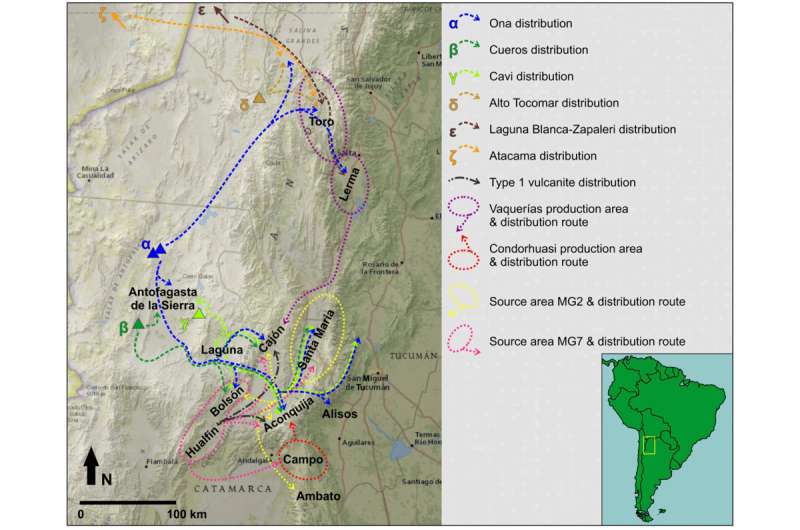May 23, 2017 report
Study provides surprisingly complex portrait of ancient trade networks

(Phys.org)—The study of ancient civilizations, particularly those that did not leave extensive writing in the archaeological record, is reliant on the evidence of other kinds of material artifacts. And one of the keys to understanding large, complex societies is mapping the circulation of such artifacts. An international research collaborative recently published a study in the Proceedings of the National Academy of Sciences on the production and circulation of artifacts in the south-central Andes during 400 BC to 1000 AD.
The study challenges existing centralized network models of interaction in favor of a decentralized network structure. The researchers built the largest provenance database ever constructed for the region, taking a multianalytical approach that considered lithic sources, pottery analysis, and comparisons of clays and fabrics. These materials and artifacts had previously only been studied separately. The wide-ranging collection of data resulted in a complex, sprawling portrait of northwest Argentina during the Formative Period.
This era was characterized by the slow development of sedentary societies with subsistence and crafting technologies. In older studies, researchers reconstructed regional networks based on typological similarities between materials and artifacts. The new study attempts to investigate interactions between both local and regional networks in the Andes during this period by comparing the manufacture and sources of materials, as opposed only to looking at styles.
For instance, an examination of obsidian artifacts demonstrated that they shared a common source. But the differences between the cultural styles and assemblages demonstrated that many groups from different communities and cultures shared access to the same source. This allowed the researchers to create a regional network representing the movement and propagation of this source of rock.
The petrography analysis of ceramics sources revealed a variety of technical production modes. The researchers found distinct chemical fingerprints for ceramic artifacts found in specific valleys and areas. "This pattern strongly suggests that there was a set of middle-range distance connections involving not only the circulation of raw materials and artifacts, but also the transmission of skills and concepts of manufacture and design that were not exclusionary," the authors note.
Notably, the study did not find characteristic artifacts from the Ambato Valley—these are distinctive gray-black wares found in past archaeological excavations that did not seem to spread among the regions encompassed by the current study. This calls into question the presumed centrality of the Ambato Valley as a node within the regional trade network. "Together with the observed low frequency of painted Aguado varieties in our core study area, the results of the geochemical analysis support a reconsideration of the purported central role of this valley," the researchers write.
The study concludes that the area supported many circulation networks involving multiple means of transport, including the presumed use of llamas. Additionally, local networks of different types were incorporated into larger regional networks that best served the needs of communities during that period–needs that were not necessarily dictated by either socio-political considerations or the desires of cultural elites. "Focusing on close intercommunity links rooted on common craft practices rather than solely on stylistic reconstructions is a more fruitful avenue to explore the ancient circulation of goods, skills, and people without assuming the capacity of early elites to manipulate and capitalize on such networks," the authors conclude.
More information: Compositional data supports decentralized model of production and circulation of artifacts in the pre-Columbian south-central Andes. PNAS 2017 114 (20) E3917-E3926; published ahead of print May 1, 2017, DOI: 10.1073/pnas.1610494114
Abstract
The circulation and exchange of goods and resources at various scales have long been considered central to the understanding of complex societies, and the Andes have provided a fertile ground for investigating this process. However, long-standing archaeological emphasis on typological analysis, although helpful to hypothesize the direction of contacts, has left important aspects of ancient exchange open to speculation. To improve understanding of ancient exchange practices and their potential role in structuring alliances, we examine material exchanges in northwest Argentina (part of the south-central Andes) during 400 BC to AD 1000 (part of the regional Formative Period), with a multianalytical approach (petrography, instrumental neutron activation analysis, laser ablation inductively coupled plasma mass spectrometry) to artifacts previously studied separately. We assess the standard centralized model of interaction vs. a decentralized model through the largest provenance database available to date in the region. The results show: (i) intervalley heterogeneity of clays and fabrics for ordinary wares; (ii) intervalley homogeneity of clays and fabrics for a wide range of decorated wares (e.g., painted Ciénaga); (iii) selective circulation of two distinct polychrome wares (Vaquerías and Condorhuasi); (iv) generalized access to obsidian from one major source and various minor sources; and (v) selective circulation of volcanic rock tools from a single source. These trends reflect the multiple and conflicting demands experienced by people in small-scale societies, which may be difficult to capitalize by aspiring elites. The study undermines centralized narratives of exchange for this period, offering a new platform for understanding ancient exchange based on actual material transfers, both in the Andes and beyond.
Journal information: Proceedings of the National Academy of Sciences
© 2017 Phys.org




















